#Diospyros Virginiana
Text


Common persimmon (Diospyros virginiana) at Hoffler Creek.
#photographers on tumblr#common persimmon#Diospyros virginiana#Hoffler Creek Wildlife Preserve#Portsmouth#Virginia#phone photo
143 notes
·
View notes
Text
one of my successfully transplanted American persimmon seedlings planted in the woods

[ID: A photo of a young American persimmon tree, less than a foot tall, in a forest floor covered in pine needles and fallen sticks. The persimmon has smooth, round, light green leaves, with yellow central-leaf-veins. Behind it and in the foreground are small, young sweetleaf shrubs, with darker, skinnier leaves. End ID.]
BTW
Here's my free American / common persimmon identification guide:
Feel free to share the link wherever you want!
#guerilla gardening#American persimmon#common persimmon#Diospyros#Diospyros virginiana#Rjalker trains its gardening skill#described images#native plants
24 notes
·
View notes
Text
Did some foraging for wild persimmons

14 notes
·
View notes
Text

3 notes
·
View notes
Photo


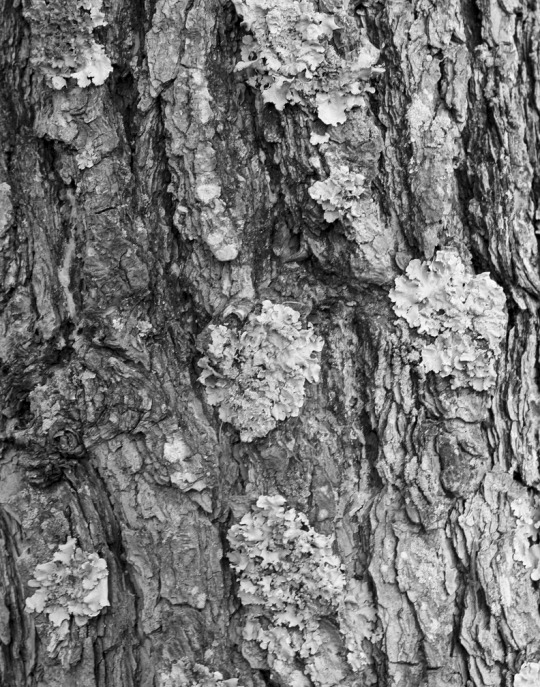
Barks of Black Cherry, Persimmon & Red Pine from my Sunday Cocoon Hunt.
#diospyros virginiana#prunus serotina#pinus resinosa#black cherry#persimmon#red pine#middlesex county#new jersey#lichen#feb#february#2023#monochrome#black and white#bark#textures#trees#nature
3 notes
·
View notes
Text
Test your small-flower and common pawpaw identification skills!
Link to the identification guide I made, on the web archive.
Link to the identification guide on google docs.
You are encouraged to download it and save for later. You are also encouraged to check with the guide while looking at the pictures below to figure out which species they are.
This is to see whether or not the guide I made can actually help people tell the various species I talk about in it apart, since I obviously can't test myself!
Please let me know of any suggestions or improvements I could make to the guide :)
Here is the quiz! If you want to see if you got it right, you can click on the link to the observation above each photo!
The multiple choice answers will just be in the same order each time because I'm lazy lol.
To repeat: You are supposed to use the guide while you look at these--it's supposed to be something you take out to the woods with you, there's no such thing as cheating!
======
#1:
Observation by kent_ozment, September 14th

[ID: A photo of a plant with large leaves with smooth edges and a bumpy texture. End ID.]
A: Common pawpaw
B: Small-flower pawpaw
C: Hickory
D: Persimmon
E: Other
======
#2:
Observation by nonbinary-naturalist September 21st

[ID: A photo taken at night with flash turned on, of a plant with deep green, smooth leaves. The stem is light brown, with a slightly pointed bud at the tip, and round buds at the base of each leaf. Some small white spots dot the leaves in a few spots. End ID.]
A: Common pawpaw
B: Small-flower pawpaw
C: Hickory
D: Persimmon
E: Other
======
#3:
Observation by elacroix-carignan, June 25th

[ID: A photo of a cluster of three fruits on a tree. The fruits are green with reddish-tinted edges, and small, with lumpy centers and pointed ends. The leaves are smooth. Part of the stem is grey with some moss on it, part is warm brown. Spanish moss hangs in the background. End ID.]
A: Common pawpaw
B: Small-flower pawpaw
C: Hickory
D: Persimmon
E: Other
======
#4:
Observation by nonbinary-naturalist, September 25th

[ID: A photo of a plant with a white hand held behind the stem. The stem is red-brown, the leaves are smooth, and have yellow veins in the center, which turns red when it connects to the stem in long sections. The buds at the base of each leaf are dark and pointy. End ID.]
A: Common pawpaw
B: Small-flower pawpaw
C: Hickory
D: Persimmon
E: Other
======
#5:
Observation by nonbinary-naturalist August 13th

[ID: A zoomed in photo of the stem of a plant. The stem is orange colored near the top, and the leaves are green, smooth, and have yellow veins in the center which turn yellow and orange when they connect to the stem in short sections. End ID.]
A: Common pawpaw
B: Small-flower pawpaw
C: Hickory
D: Persimmon
E: Other
======
#6:
Observation by nonbinary-naturalist, April 28th
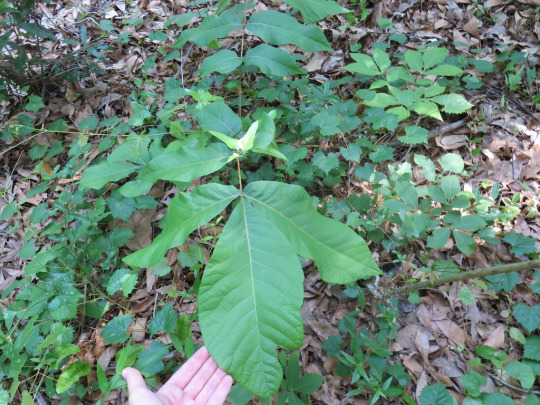
[ID: A slightly blurry photo of a white hand holding up a large, wrinkly leaf on a small sapling. The leaf is very large, and has two smaller leaves at its base pointing to the sides. The ground in the background is covered with brown dead leaves and wild muscadine grape vines. End ID.]
A: Common pawpaw
B: Small-flower pawpaw
C: Hickory
D: Persimmon
E: Other
======
#7:
Observation by thorlovescake, August

[ID: A photo of a hand holding the tip of a leaf from a stem. The leaf is smaller than the hand, green, smooth, and shaped like an oval. Several more leaves hang down near it, emerging from the tip of the brown stem, which has a rounded, dark bud at the top. Some small black spots are scattered on the leaves. Where the leaves connect to the stem, they are round and pale yellow. End ID.]
A: Common pawpaw
B: Small-flower pawpaw
C: Hickory
D: Persimmon
E: Other
======
#8:
Observation by onondagaearthcorps, October 10th
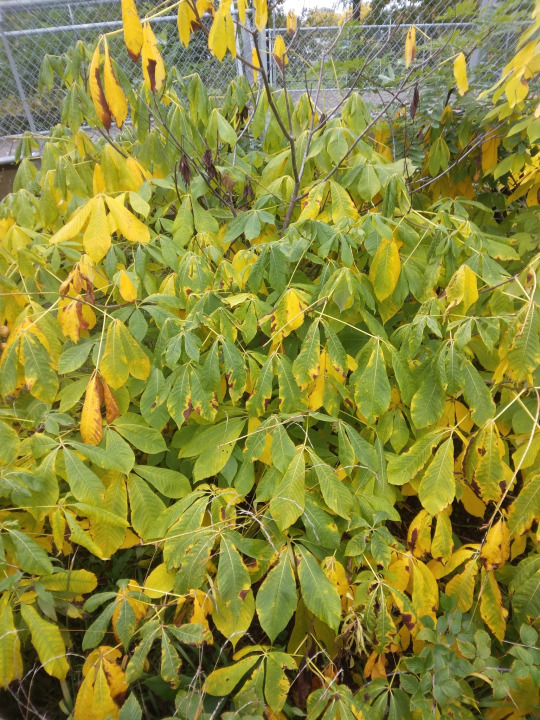
[ID: A photo of a large plant with its leaves all pointing towards the ground, and changing from green to yellow with the fall. The leaves are wrinkly, serrated, and are in groups of five at the end of a long section attaching it to the stem. End ID.]
A: Common pawpaw
B: Small-flower pawpaw
C: Hickory
D: Persimmon
E: Other
======
You can either just click the Observation link to see how well you did yourself or submit your answers in an ask, with the question's number, then the letter you chose, and I'll grade you and explain anything you got confused on :)
#long post#described images#plant identification#pawpaws#asimina#asimina parviflora#asimina triloba#diospyros virginiana#carya#Aesculus hippocastanum#aesculus#diospyros#Nyssa#Nyssa sylvatica#tupelos#tupelo#hickory#persimmon#pawpaw#horse-chestnuts
3 notes
·
View notes
Text
Has anyone here ever canned whole persimmons in syrup? I'm finding a lot of indications that this used to be a method of preservation (W. F. Fletcher's The Native Persimmon, USDA 1915 is one source, there's also a reference to that in Southern Provisions by David S. Shields), but I haven't seen any modern recipes and some stuff that I'm reading says that it would need to be either pressure canned or preserved with lemon juice to increase the acidity? American Persimmons have a pH of around 6.10, which is possibly hazardous for canning. Does anyone know more?
0 notes
Video
Wild Persimmons (Diospyros Virginiana) by florjus
Via Flickr:
Wild Persimmons (Diospyros Virginiana)
#Wild Persimmons#Diospyros Virginiana#Trees#Fruit Trees#Native Trees#Deciduous#flickr#photographers on tumblr#fall#autumn
1 note
·
View note
Text
Up Hickory Hollow
The massive shagbark hickory that gave Hickory Hollow its name when I was a child fell a long time ago, but there are still plenty of hickory trees there, and we still call it that.
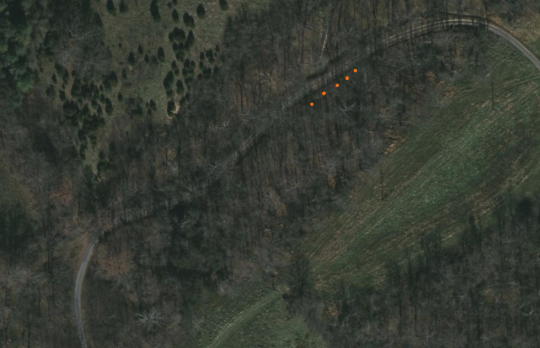
It is, roughly, an area of somewhat scruffy woods about 50 yards wide by 150 yards long, and a gravel road winds through it. That's where we've been cutting firewood (the orange dots), and where I found the oddball shelf fungus recently.
Further up, across a field and a bit beyond this map, is a huge sinkhole. The kind that could have swallowed a house. It used to be part of a pasture, when my father had cattle. Now it has mature trees growing in a ring around it, and lines of trees from the 2020 planting (with "tree tubes" to protect them) stretching away on either side.
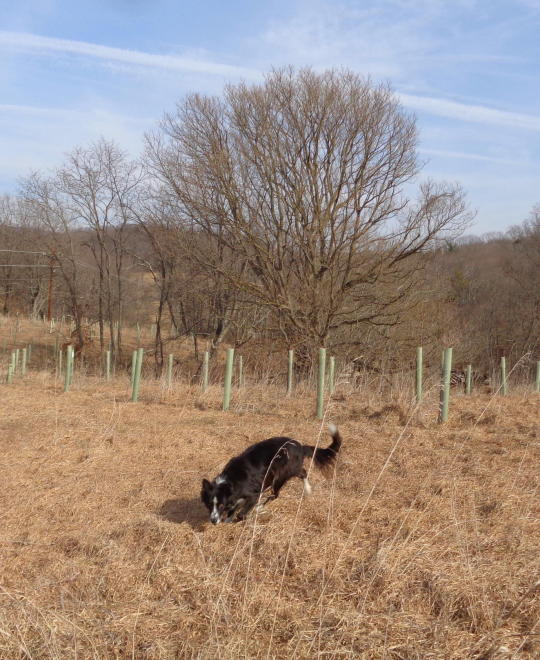
Where the land seems to dip, there, is actually a big hole that *must* be connected to a cave system of some kind, but it's too dangerous to poke around the bottom. It could collapse further with no warning. The smaller trees on the left are a group of about 5 persimmons. Diospyros virginiana, to be precise. They are wild, the fruits are much smaller than the domesticated ones you see in the market, and only edible after frost.

The grass is too tall under the trees to find the dropped ones easily. Hmm.

Bit by bit, she shinnied up there until she could shake the branches. Then I had to scamper about picking up the fruit. The fact that they're ugly does not mean that they are spoiled.

Inside, they are a deep orange color, mushy texture, and very sweet. Most of them will be left for the wildlife. I wouldn't mind getting some more trees started, though, and encouraging them to keep their lower limbs so they're more climbable.
The wikipedia article is a wild ride. Look for the part about persimmon bezoars!! eEEee
37 notes
·
View notes
Text







Assorted selected seedlings, l-r, top to bottom: sugar pine (Pinus lambertiana), American persimmon (Diospyros virginiana), Acacia tysonii (now with phyllodes!), Erythrina herbacea, Bursera fagaroides, jojoba (Simmondsia chinensis), and Kentucky coffeetree (Gymnocladus dioicus).
15 notes
·
View notes
Text
I am having a go at growing bonsai from seed.
I have three options and plan to attempt to grow all of them, but:
Common Hackberry (Celtis occidentalis) is a native tree in the area where I reside, notable for its high-calorie edible berries, distinctive ridged bark that makes for a marvelous rough surface on well-maintained bonsai.
American Persimmon (Diospyros virginiana) is the native variety of my favorite fruit, a species of ebony bearing a strong close-grained wood and just barely edging into my region. It produces beautiful white flowers and vibrant orange fruit after some years.
Coastal Redwood (Sequoia sempervirens) is the tree of my system's youth, on which we had our childhood treehouse and which rose over our head in kindergarten. It is a fire-resistant tree that often recovers strongly from burning damage, a beautiful evergreen that lives for centuries amidst the coastal fogs.
2 notes
·
View notes
Text
Neopronouns in action: it/its/itself
EX:
"It is going to adopt a new puppy soon, as soon as it gets a fence set up around its yard so the puppy can go outside without it having to walk it. Its uncle is going to help set up the fence, since he has a set of power tools he's letting it use, since it lost its."
This is also a free writing prompt!
===
The Interworld Growing Club
It was the first human to join the transworld growing club, and it brought Sambucus canadensis, Diospyros virginiana, Prunus caroliniana, and Passiflora incarnata seedlings with it as the four traditional gifts.
Each new member brought with them four species native to their planet that weren’t already included in the collective.
It wasn’t the first new member to join, or the only first of its species - on the same planetary cycle (defined by the system’s governing council as being forty-seven hours long), the first seyeir also joined, and zainun brought four species whose names the human couldn’t remember how to pronounce (and thus, remember) yet.
Most of the other members of the club had never met a human before, since they were still so new to having interstellar travel capabilities, so the pre-approved list of questions it was okay to ask almost got used up entirely.
How often did it need to sleep? What did it eat? How often did it need to eat? What did it drink? Did it eat the species it had brought with it? Were the species it had brought with it pets? Did it have any pets, and if it was safe, could they meet them?
How long did it need to sleep? Was it telepathic? Did it have any disabilities among its species? Could it smell their pheromones? Could it see their colors? Did it know what dreams were? Did it dream? Did it remember its dreams? Was this its first time leaving Earth? How many planets had it gone to? How many space stations had it gone to?
What was the spaceship it had come here in called? What was its favorite color? What was its favorite sound? Did it have a favorite time? What was its favorite food?
How many genders did humans have? What was its gender? What were its pronouns? If it was attracted to any genders, what kinds of genders was it attracted to, and how?
Would it be interested in courting an alien? Did humans lay eggs? Did humans reproduce by budding? How did it get its name? Did it have any siblings or parents or friends?
How long could it stand? How much weight could it lift? Did it take any medicines? What should they do if it was injured and couldn’t help itself? What should they do if it stopped breathing?
How long could it survive in the vacuum of space? What should they do if it was exposed to the vacuum? What should they do if it got too hot? What should they do if it got too cold?
What kinds of foods could it eat? Would it show them how humans cooked and ate the species it was gifting to the collective?
The last question would take a while to come to fruition, because the seedlings it had brought with it were still very small, and wouldn’t produce fruit for anywhere from a few months to several years. And the Prunus caroliniana wasn’t edible for humans, but the on-station medical experts had concluded that the fruits would be edible for several of the other member species, which was why it had chosen it as one of the gift species. The other three were edible for humans, and for half a dozen member species, each.
Three other members were delighted that it used it/its pronouns, just like they did, though they each described their genders very differently than it did.
Once the questions were done, it was led on a tour of the communal growing area, where, safely contained behind several layers of state-of-the-art forcefields, physical walls, airlocks, and other safeguards to prevent any escapes, all of the hundreds of species that had been gifted to the growing club were cultivated in a self-contained, self-sustaining, completely unique ecosystem.
Each new species was carefully integrated into the rest so that its outputs and inputs would work in a careful balance with the rest of the system, so that each species got what it needed, and gave what it didn’t. The species weren’t limited to what humans called plants, either, since most non-Earth species didn’t conform to anything that could easily be categorized within the normal Earth standards. What humans called plants, animals, and mushrooms were all involved, as well as hundreds of species human taxonomists hadn’t even begun to think about sorting.
The four species the human had brought with it would be given their place, once they were studied and understood by the club members who were most familiar with the system, and until then, they had much to teach the human, who was more than happy to learn, and ask its own questions.
#long post#neopronouns in action#neopronouns#writing prompts#neopronoun writing prompts#trans#transgender#nonbinary#xenogender#pronoun nonconforming#queer#mogai#pride#lgbt#ititspronouns#it/its#it/its/itself#science fiction#scifi#scifi writing prompts#science fiction writing prompts#aliens#alien farming#alien gardening#don't turn this into some stupid human-centric ''h*mans are sp*ce or*s'' bulshit.#censored so it doesn't show up in that stupid tag.#ectopronouns in action
9 notes
·
View notes
Text
Where can I find out the indiginous names for Diospyros virginiana?
I only found this so far
The word persimmon comes from putchamin, pasiminan, or pessamin, from Powhatan, an Algonquian language, meaning "a dry fruit."
6 notes
·
View notes
Text

Diospyros virginiana my beloved (not my photo, I just really like persimmons)
1 note
·
View note
Text

Our area is rich with traditional folklore, including some amazing weather lore. Perhaps you've heard of predicting the upcoming winter by Wooly "Worm" caterpillars, hornet nests, or August fogs. But have you heard of the persimmon method? Tradition says to slice open ripe persimmon seeds and look at the embryo tree inside. If it looks like a spoon, it's going to SPOON a lot of snow down. If the embryo looks like a knife, it's going to be cold but dry - cold CUTTING winds. And if it looks like a fork or plate, it's forecasting a mild winter, so mild that you could EAT outdoors. 
Persimmons are small orange fruits that are less well known the plums or peaches, but they can be found in some grocery stores and farmers’ markets during autumn. The American persimmon trees (Diospyros virginiana) grows wild in USDA Zones 4 to 9, while Japanese persimmon trees (Diospyros kaki) thrive in only the warmer part of that range—Zones 7 to 9. Before they’re ripe, the fruit has a very astringent taste, but this mellows as the fruit softens. For the purposes of weather forecasting, you’ll want to get your hands on an American persimmon which has seeds.
Persimmons have a unique fall flavor that is similar to pumpkin. A ripe persimmon has a “squishy” body and a creamy texture so it’s often considered a baking fruit, adding its sweet flavor and moistness to pudding, bread, and pie. Persimmons can also be made into dried fruit, jam, ice cream, and even alcohol.
🥄 Read more at https://www.almanac.com/predicting-weather-using-persimmon-seed
#appalachian#appalachian mountains#north carolina#appalachian culture#western north carolina#appalachia#the south#nc mountains#mcdowell county#mcdowellcounty#appalachian folklore#folklore#persimmon
0 notes
Text
tried an american/common persimmon (diospyros virginiana) bc i found some nearby and honestly? 4/10. was a little sweet but mostly very very dry. it was quite ripe btw. i may have left it to chill too long :(
0 notes